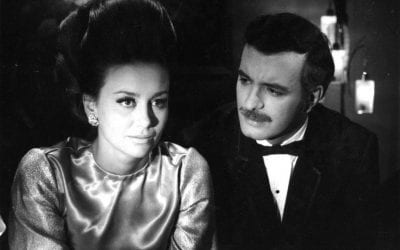Hybrid Fiction in Latin America
The father of a friend of mine became hooked on Avenida Brasil, a Brazilian telenovela that was a hit in several Latin American countries. Every night, as he sat down to watch the telenovela, he insisted that he was going to watch his “series,” never acknowledging he was actually watching a telenovela. The “genderization” of television is not what I intend to discuss here—NYU professor Juan Piñon has already examined that subject in many articles—but rather the fact that the audience seems to need to name what it is watching. And naming television fiction genres in Latin America has become complicated in the last decades.
Authors like Jason Mittel, Christine Gledhill and Daniel Chandler have tried to define the genres, explaining their use for the producers and for the audience. To assign a genre category to a program is a way to assign some consistent rules to it, making it easier for the producer to know what has to be done, and for the audience to know what to expect from that program. If we are promised a comedy we expect to laugh and watch a show that will leave us in a good mood once it ends. If we watch a detective story we know there will be crime, suspense, and a mistery that must be solved. The producers of such shows know they must rely on certain kinds of characters, locations, props and circumstances, and that a certain group of screenwriters will be more suitable to write the scripts of one type of show than another.
Comedy, drama, police/detective fiction, horror, adventure, fantasy are only a few of the fictional television genres. Chandler warns us that the list will never be finished, and that categorization of genres varies from country to country. Most people seem to understand and identify the main genres and their respective formats –the way they are actually shown and programmed on a station. A drama may be shown as a series (weekly, most of the times), as a mini-series (defined number of episodes that will tell the whole story, from start to finish), as a TV movie (a two-hour fiction narrative shown on a specific day), or in some other format. That way of categorizing stories and their delivery seems simple and routine to the audience, unless we start to mix genres or formats, making it a hybrid genre.
In Latin America one of the most important television genres (if not the most important one) is melodrama, a genre that began with popular performances in the 16th century and developed both in theatres and on the streets, shown in the 20th century on film, heard on the radio and seen on television. Its narrative usually deals with human passions, love, betrayals, secrets, and its characters express their feelings in a very excessive, emotional and intense way. Colombian theorist Jesús Martín-Barbero calls it a “rhetoric of excess.” The main format for melodrama in Latin America is the telenovela, and in the United States, England and Australia, it is the soap opera (which does not have a defined ending, as does the telenovela).
When I ask my students in class who watches telenovela, most of the times only a few raise their hands, mostly female students. When I start talking about some very popular telenovelas, and make mistakes about their stories, I am corrected by my students, who remember better than I the names, situations, relationships and arguments. It is not unusual, however, that those who correct me are male students, those very students who did not raise their hands when I asked who watches telenovelas.
Although melodrama exists in other formats like series, mini-series or TV movies, the fact is that the only genre shown in the format of a telenovela is melodrama. So, watching a telenovela means to be watching melodrama. When my friend´s father argued that he watched a series and not a telenovela, he was actually not saying that he didn´t acknowledge the format he was watching. He was saying that he wasn’t watching melodrama, considered by some people a female or low cultural product that men or highly educated people supposedly don´t watch. So, why is he watching it? What does he think he is watching? What attracts him to this show in a genre he hadn’t watched before? Latin American melodrama lately has been mixing plots, characters and scenarios that weren´t part of the classic canon. Argentine, Colombian and Brazilian telenovelas have spiced up the central plots of romantic love, deceit and betrayal with other qualities more generally associated with a detective story, a fantasy tale, a comedy or a musical.
If the classic 60s and 70s telenovela always had the main female character marrying the main male character in the end, several modern telenovelas give much less importance to this romantic happy ending than to other aspects of the plot. I don´t mean to say that the romantic tale isn’t important, or that most of the time the main characters won’t end up together at the end, but with the inclusion of other kind of stories in the telenovela that can be just as important as the romantic tale. In a mid-90s Brazilian telenovela, for example, several characters were targeted by a serial killer—just as important as ongoing romantic entanglements. The audience tuned in night after night to learn who was going to be “the next victim”—which was also the name of the telenovela—and who the assassin was. Detective story or melodrama? Actually both, mixed to form a hybrid.
Colombia and Mexico have extended this kind of plot with the so-called narconovelas, in which stories of men and women in the drug trafficking are mixed with the romantic tales of the telenovelas. At first, the stories came from books and were adapted into melodramas with variable length—30 to 60 episodes—and screenwriters later developed full telenovela lengths. The driving force of the action shifted: if two characters in traditional telenovelas would fight each other to win the love of a character of the opposite sex—which made them behave in unethical ways—now power, wealth or fame motivate their actions. Romantic love isn´t as important as getting away from the police or their enemies, and keeping their drug business running. Action, suspense, a lot of glamour and life on the fast lane has a higher presence in this kind of telenovelas, with love and romance just as another part of the story that is being told. In these narconovelas, the classic victim (most of the times a leading female character), hero (most of the times a man who would end up marrying the victim) and antagonist (man or woman, depending if the character wants the love of the victim or the hero) may be antiheroes, characters of dubious morality, and not necessarily “people of good intentions,” as was almost always the case in traditional melodramas.
In other types of the new Latin American telenovela, a stock character of the classic melodrama has managed to steal some of the plots. In classic melodrama the fool is the comic relief, allowing the audience to take a break from all the sorrows and tears, and have a moment of laughter before the plot goes on. In some current telenovelas, comedy has become an essential part of the narrative. Sometimes we must end up asking ourselves, “Are we suppose to be laughing so much in this story? Where is the ‘drama’ in this melodrama? Or is it a comedy” It is there, let’s not be fooled, but comedy has taken the drama under its wing, and will build up to the most agonizing moments when we are the least prepared for them. Love stories will still be a huge part of what is important, and no laughter will derail the main plot from that. But funny and light scenes, amusing and comical, will be constantly blended with the melodramatic scenes. It’s interesting to see that one of the most popular telenovelas that relied on comedy—the Colombian Betty la fea—was remade in the United States, stripped of all its typical melodramatic core, and turned it into a sit-com, instead of making it into a soap opera with a comic turn. Is it possible that soap opera isn´t ready for hybrid projects?
Fantasy and adventure are also new elements in Latin American telenovelas. Argentine telenovelas in the 1990s were the first to mix melodrama with fantasy tales more commonly associated with stories for children. Nevertheless these telenovelas did not targeting a juvenile audience (although there have indeed been telenovelas designed for children or youth), but rather aimed at a typical adult female target. For some years, Argentines seemed to prefer to focus more on fantasy stories, farther away from social melodrama, as they healed their own past of the military government or the Malvinas war. Telenovela scholars Nora Mazziotti, Maria Victoria Bourdieu and Oscar Steimberg have studied this relationship between the social moment, and the themes television fiction chooses to tell.
Hybridization has become a fact in several television genres and formats, and it’s a fact of life for melodrama too. Regardless of whether it mixes melodrama with comedy, detective stories, fantasy, thriller, musical or crime stories, the hybrid genre has been broadening its audience, luring viewers from various directions in the last decades. Classic melodrama centered on romantic love isn´t as appealing to younger audiences as are telenovelas with a mix of comedy, music or fantasy. Male audiences increase when crimes, drugs, action or mystery are mixed with romance. And the audience doesn´t care what scholars call these shows or how the TV station markets them.
In Peru a television production company called its shows “mini-telenovelas,” though they seem to be more like mini-series (five episodes long). That title seemed more appealing for its audience, when romantic love wasn´t the main subject of the story. Did this branding work for them? The producers seemed happy with the results, and they broadcasted two more seasons.
We initially observed that a genre tells the audience what to expect from the show and helps the producer know what has to be done, so how do these hybrid genres work in this sense? The key is that in hybrid telenovelas the melodrama is always established in the first episodes, commanding a weighty presence in dramatic developments. Only later do the other elements that will be part of the hybrid product come into play, and then the audience may start expanding, because viewers seem to recognize elements of other genres. But this hybrid process can also happen in reverse….
Ien Ang’s research on the television show Dallas shows how melodrama was inserted into a show that was supposed to be a dramatic weekly series. Ang stresses that Dallas had much in common with the melodramatic aspects found in soaps and telenovelas. Love affairs were as important for the audience as the power struggles and political schemes of the Ewing family. In a show driven at first by the elements of a recognized genre, melodrama can start to appear at some point in some shows and lure other audiences, to become a huge success.
The hybrid genres of the telenovela and other shows will keep on working for certain audiences. Not all telenovelas will be hybrid, and those that choose that path will always have enough of the basic aspects of the genre to satisfy the core audience. Changing the formula is just a way to answer the changing demands of television nowadays.
Fall 2017, Volume XVII, Number 1
James A. Dettleff is an Audiovisual Professor at Pontifica Universidad Católica del Perú, currently pursuing a Ph.D. in communications at Universidad Católica de Chile, researching TV series and films as part of the collective memory of the internal war in Perú.
Related Articles
Telenovela Heroines
I first became interested in telenovelas as an academic subject when, more than thirty years ago, I heard my then two-year-old daughter sing a song for the first time. It was the opening…
Sharing Latin Loves in Lithuania
When I was growing up in Lithuania, at the time the country transitioned from the Soviet rule to independence, my grandmother and I used to watch Mexican and Venezuelan telenovelas…
Narconovelas
n May 2017, the acclaimed band Los Tigres del Norte was fined $25,000 for singing a couple of narcocorridos (traditional Mexican ballads with lyrics that tell of the exploits of drug traffickers)…





